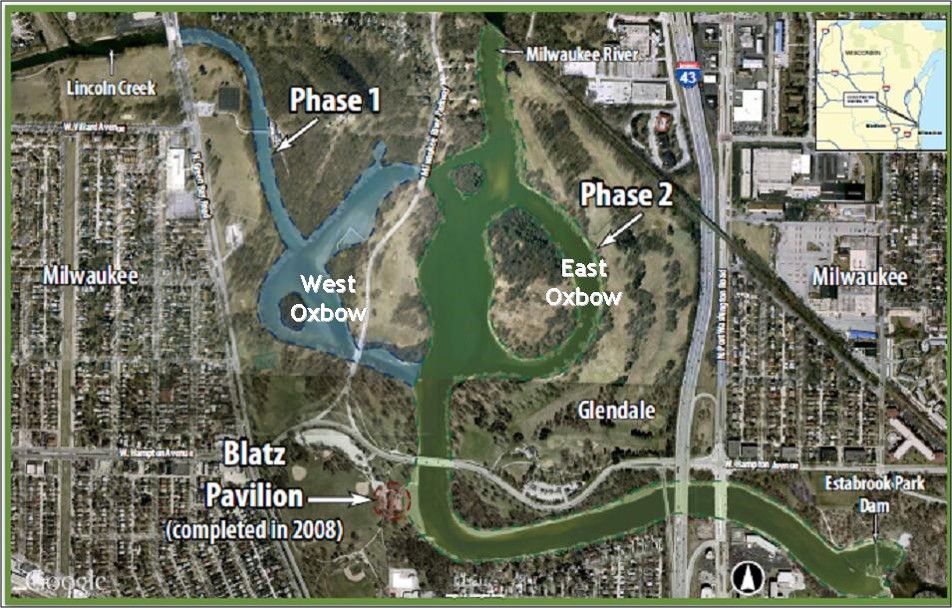The sediment cleanup of Lincoln Park is complete!
At 310 acres, Lincoln Park is one of the largest in Milwaukee. Managed by Milwaukee County Parks, it offers a golf course, an aquatic center, athletic fields, bike trails, picnic areas, and open natural spaces to neighboring communities. The Milwaukee River flows through the park. Thanks to a recently completed set of Great Lakes Legacy Act cleanups in the river, along with ongoing habitat restoration, Lincoln Park can now reach its full potential as an environmental and neighborhood asset.
Before the sediment cleanup work began, the sediment found here contained 70 percent of the river's PCB contamination. Investigations revealed that other contaminants include PAHs and NAPL, and the source is believed to be former industrial activity in Lincoln Creek.
Before the sediment cleanup work began, the sediment found here contained 70 percent of the river's PCB contamination. Investigations revealed that other contaminants include PAHs and NAPL, and the source is believed to be former industrial activity in Lincoln Creek.
Location
The Milwaukee River flows through Milwaukee County's Lincoln Park. Phase 1 of the sediment cleanup included a portion of Lincoln Creek and the West Oxbow, and Phase 2 included the East Oxbow and the river upstream of the Estabrook Park Dam. The Blatz Pavilion sediment cleanup location is also shown below.
Cleanup Process
|
Phase 2
Sediment remediated: 52,000 cubic yards Contaminants: PCBs, PAHs, and NAPL Method: Dry excavation and hydraulic dredging When: 2014 and 2015 Partners: U.S. Environmental Protection Agency, Wisconsin Department of Natural Resources, and Milwaukee County Parks Cost: $18 Million Note: This portion included the restoration of 1.5 acres of habitat. |
Phase 1
Sediment remediated: 119,000 cubic yards Contaminants: PCBs, PAHs, and NAPL Method: Dry excavation When: 2011 and 2012 Partners: U.S. Environmental Protection Agency, Wisconsin Department of Natural Resources, and Milwaukee County Parks Cost: $24.6 Million Note: This portion included the restoration of 11 acres of habitat. |
Long-term Benefits
Click here to see where the Before and After pictures were taken in Lincoln Park.
|
|
Take a virtual tour of the remediated Lincoln Park and Milwaukee River by drone. The river looks like a patchwork grid because sediment in Phase 2 was removed from targeted zones of contamination, rather than a mass removal from bank to bank. The grid is made more noticeable by the low water levels in the park, which cause vegetation to grow on exposed sediment. Construction areas have been restored to original condition, including turf grass and park amenities. Video credit: Duane Thomas
More Information
Documents and Resources
Urban environmental equity in Milwaukee research reports
Community needs assessment for stewardship and outreach (PDF, 21p, 1MB) August 2014
Lincoln Park Great Lakes Legacy Act handout (PDF, 2p, 257 KB) August 2013
Lincoln Park Phase 1
Final Construction Completion Report (PDF, 439p, 117MB) June 2013
Public Meeting Presentation (PDF, 35p 7.2MB) February 2012
Basis of Design Report (PDF, 534p, 40MB) March 2011
Feasibility Study (PDF, 88p, 2.4MB) December 2009
Final Focused Remedial Investigation Report (PDF, 71p, 39MB) August 2009
Lincoln Park Phase 2
Phase 2 Final Remedial Action Report (PDF, 772p, 14.6MB) June 2016
Remedial design public meeting poster (PDF, 1p, 1.86 MB) May 2014
Phase 2 Final Design Report (PDF, 264p, 57.7MB) May 2014
Feasibility study report (PDF, 122p, 4MB) October 2013
Sediment deposits poster (PDF, 1p, 1.39 MB) August 2013
Final Remedial Investigation Report (PDF, 1646p, 37MB) March 2011
Urban environmental equity in Milwaukee research reports
Community needs assessment for stewardship and outreach (PDF, 21p, 1MB) August 2014
Lincoln Park Great Lakes Legacy Act handout (PDF, 2p, 257 KB) August 2013
Lincoln Park Phase 1
Final Construction Completion Report (PDF, 439p, 117MB) June 2013
Public Meeting Presentation (PDF, 35p 7.2MB) February 2012
Basis of Design Report (PDF, 534p, 40MB) March 2011
Feasibility Study (PDF, 88p, 2.4MB) December 2009
Final Focused Remedial Investigation Report (PDF, 71p, 39MB) August 2009
Lincoln Park Phase 2
Phase 2 Final Remedial Action Report (PDF, 772p, 14.6MB) June 2016
Remedial design public meeting poster (PDF, 1p, 1.86 MB) May 2014
Phase 2 Final Design Report (PDF, 264p, 57.7MB) May 2014
Feasibility study report (PDF, 122p, 4MB) October 2013
Sediment deposits poster (PDF, 1p, 1.39 MB) August 2013
Final Remedial Investigation Report (PDF, 1646p, 37MB) March 2011




